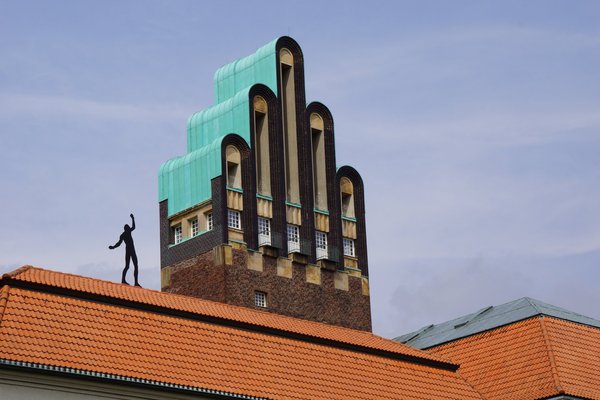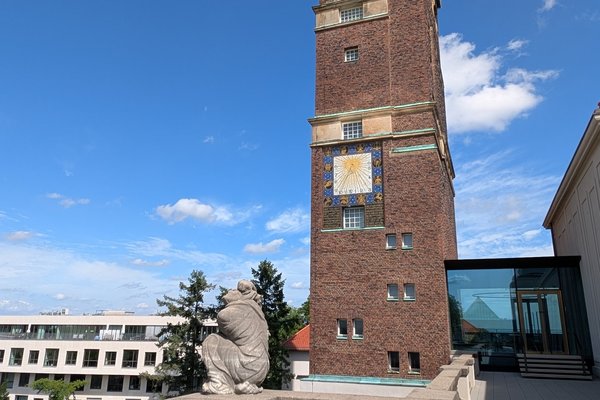Germany
Mathildenhöhe Darmstadt
Mathildenhöhe Darmstadt represents the architectural and artistical transition from Art Noveau to Modernism.
Founded by the Grand Duke of Hesse, Mathildenhöhe evolved as a semi-utopian community with innovative artists’ houses and studio buildings (1899-1914). The cityscape was further embellished via four pioneering international building exhibitions, and their permanent buildings have resulted in a “Gesamtkunstwerk”.
Community Perspective: This occupies a relatively small area within Darmstadt. Visit the Museum “Künstlerkolonie”, the best introduction to the works of interior decoration of this group of artists and about the only place you can enter except for the Wedding Tower.
Site Info
Official Information
- Full Name
- Mathildenhöhe Darmstadt (ID: 1614)
- Country
- Germany
- Status
-
Inscribed 2021
Site history
History of Mathildenhöhe Darmstadt
- 2021: Advisory Body overruled
- From Referral to Inscribe
- 2021: Inscribed
- Inscribed
- Type
- Cultural
- Criteria
- ii
- iv
Links
- UNESCO
- whc.unesco.org
- Official
-
- mathildenhoehe.eu — Institut Mathildenhöhe
- Related
-
- darmstadt-tourismus.de — Darmstadt Tourism website
All Links
UNESCO.org
- whc.unesco.org — whc.unesco.org/
Official Website
- mathildenhoehe.eu — Institut Mathildenhöhe
Related Resources
- darmstadt-tourismus.de — Darmstadt Tourism website
Community Information
- Community Category
- Urban landscape: Post-medieval European
Travel Information
Frankfurt hotspot
Recent Connections
-
Russian Revival architecture
Russian Chapel in Darmstadt (1897)
-
Named after individual people
Named after Mathilde Karoline von Bayer… -
Universities
The property contains the Darmstadt Uni…
Connections of Mathildenhöhe Darmstadt
- Individual People
-
-
Ludwig Mies Van Der Rohe
"(...) prominent architects of the twentieth century, among them Frank Lloyd Wright, Erich Mendelsohn and Ludwig Mies van der Rohe, expressly named the Mathildenhöhe as a source of inspiration and disseminated its influence into the world through their works." (Nomination file, p. 148)
-
- Trivia
-
-
Dubbed as another WHS
"From 1908 on, the Mathildenhöhe was called the "new Acropolis"." – "As early as 1908, the Wedding Tower and the Exhibition Hall ensemble was likened to the Acropolis: "Olbrich's construction will not only draw attention to its content, which, with its various elements [...], crowns the exhibition hill like an acropolis."" (Nomination file, p. 29, 118)
-
- Architecture
-
-
Gesamtkunstwerk
The colony "was realised by now renowned architects such as Joseph Maria Olbrich and Peter Behrens in the form of a permanent "Gesamtkunstwerk", a total artwork that is seminal in the history of architecture." (Official description) -
Exhibition gardens
"From the very beginning, the comprehensive artistic design of the entire "Mathildenhöhe Darmstadt" site also included the careful planning and furnishing of the external areas, open spaces and green spaces. Detailed plans for the design of domestic gardens, enclosure walls, fences, and the placement of sculptural works rounded off Joseph Maria Olbrich's overall plans for the Darmstadt Artists' Colony ensemble from 1901. The subsequent expansion phases at Mathildenhöhe also continued the careful planning of the landscapes and gardens, especially in connection with the exhibitions of 1908 and 1914 in which the surroundings of the Russian Chapel and the Exhibition Hall were redesigned and the Plane Tree Grove refurbished." (Nomination file, p. 199) -
Domes
The onion domes of the Russian Chapel (Nomination file, p. 30) -
Russian Revival architecture
Russian Chapel in Darmstadt (1897)
-
Art Nouveau
Ernst Ludwig brought together several artists of the Art Nouveau in Darmstadt: Peter Behrens, Paul Bürck, Rudolf Bosselt, Hans Christiansen, Ludwig Habich, Patriz Huber and Joseph Maria Olbrich. (wiki) -
Conical roofs
Swan Temple: "An architrave of cast stone carries a flat dome covered by a conical copper roof." (Nomination file, p. 86) -
English garden
"The history of the nominated property began in 1800, when Prince Christian of Hesse-Darmstadt created an English landscape garden open to the public on the hill above the city of Darmstadt, from which views of the city could be enjoyed." (AB Ev) -
Expressionist architecture
"With the Wedding Tower, Olbrich succeeded in the development of a proto-expressionist architecture which refers far into the future and anticipates the repertoire of forms of the architectonic expressionism and the new building philosophy of the 1920s. (...) The design of the tower (...) suggest the architectural forms of architectonic expressionism, which were manifested in the architectonic new beginnings of European architectural history after the First World War." (Nomination file, p. 67-68) -
Glazed tiles
Russian Chapel: "Its design typifies the architecture of historicism, common throughout Europe during these years, which draws from the wealth of forms of architectural history and brings it into the present with new materials and designs. An example is the architect's extensive use of faience, not common in historical Russian architecture, on the facades of the chapel." (Nomination file, p. 30) -
Modern Urban Planning
The colony "offers a testimony to early modern architecture, urban planning and landscape design, all of which were influenced by the Arts and Crafts movement and the Vienna Secession." (Official description) -
Mosaic art
"In Alexandraweg, Prinz-Christians-Weg as well as Christiansenweg, (...) the two-metre-wide pavements to the left and right of the road are constructed with elaborate, original mosaic sett pavings. Their geometrical shapes made from various stone materials are not only decorative and lead the eye, but also guide to the individual houses by accentuating their entrances." (Nomination file, p. 28) + Exhibition Hall: "The main entrance is reached via a U-shaped stairway located in front of the southwest corner of the viewing platform. It leads first to a landing protected by an open canopy resting on granite columns. Its inner dome is decorated with mosaics and shows the Hessian heraldic animal, the lion, surrounded by stylised animal motives and the motto of its constructor, Grand Duke Ernst Ludwig". (Nomination file, p. 64) – The Wedding Tower has a "centrally located portal with lavish mosaics". The vestibule of the Tower has mosaic decorations too, by Friedrich Wilhelm Kleukens, The Kiss and The Loyalty. (Nomination file, p. 68, 72)See de.wikipedia.org
-
Octagons
Sculptor studios: "The basic shape of the large, heated skylight studio is square, integrating an octagonal tower at the northwest corner." (Nomination file, p. 59) -
Reinforced Concrete
The Wedding Tower "consists of a clearly detached base level constructed in reinforced concrete, a high tower shaft with exposed brickwork, and a marked roof of glazed brick and sheet copper." – "The formerly five-storey Studio Building was constructed with a reinforced concrete skeleton." (Nomination file, p. 68, 94) -
Vienna Secession
The colony "offers a testimony to early modern architecture, urban planning and landscape design, all of which were influenced by the Arts and Crafts movement and the Vienna Secession." (Official description) + Joseph Maria Olbrich, who had designed the 1898 Secession Building in Vienna was appointed to the art colony by Grand Duke Ernst Ludwig. (Nomination file, p. 180-181) -
Artists' houses
The property contains artists' houses. These are residential houses that were the homes of the artists and other important persons close to the artists' colony, e.g. Olbrich House, Habich House, Small Glückert House, Behrens House. "The Darmstadt colony artists' houses are part of a great tradition of artists' houses, while at the same time pointing beyond this tradition through their creative innovation and programmatic function as part of an exhibition, together with their communal character." (Nomination file, p. 32-56, 202, 238) -
Early Modernism
"The buildings of the colony were created by its artist members as experimental early modernist living and working environments." – "Mathildenhöhe Darmstadt is an outstanding early-twentieth-century ensemble of experimental buildings and designed landscapes that represents a prototype of Modernism." (Official description) -
Brick architecture
brick architecture (Hochzeitsturm - Wedding Tower)
-
- Damaged
-
-
Damaged in World War II
"The following buildings were damaged in the late summer of 1944 during the Second World War: the Behrens, Christiansen, Habich, Keller and Olbrich houses from the 1901 exhibition; the Three House Group from the 1904 exhibition; the Exhibition Hall from the 1908 exhibition; and the group of tenement houses from the 1914 exhibition. Some of the damaged buildings were removed during the 1950s. Others were rebuilt differently or converted for new uses. The Ernst Ludwig House was purchased by the city in 1951 and converted for cultural use. Damaged buildings that were in public ownership, such as the Exhibition Hall, were safeguarded after the war." (Ab Ev)
-
- Religion and Belief
-
-
Russian Orthodox churches outside Russia
Russian orthodox church St. Mary Magdalene
-
- Human Activity
-
-
Art Colonies
The Darmstadt Artists’ Colony was established in 1899 by the Grand Duke, who appointed seven artists for three years. (AB ev) -
Ateliers
"The serial property consists of two component parts including 23 elements, such as (...) the 13 houses and artists' studios that were built for the Darmstadt Artists' Colony and for the international exhibitions." (Official description) – The Ernst Ludwig House was conceived as a "joint studio for all artists (...) The studio building was used in 1901 to provide equal workplaces for the seven founding members of the artists' colony." (Nomination file, p. 34)
-
- Constructions
-
-
Cenotaph
Plane Tree Grove: "The middle of the west side, precisely opposite the Olbrich wall fountain, is dominated by the cenotaph for the painter Paula Modersohn-Becker, who died in childbed." (Nomination file, p. 92) -
Elevators
In the Wedding TowerSee de.wikipedia.org
-
Loggia
The Upper Hessian House has a loggia. (Nomination file, p. 76) -
Monumental Fountains
Ernst Ludwig Fountain -
Sundial
At the Wedding TowerSee de.wikipedia.org
-
- Timeline
-
-
Built in the 20th century
For the international exhibitions in 1901, 1904, 1908 and 1914
-
- WHS Hotspots
-
-
Frankfurt hotspot
30 minutes from Frankfurt
-
- Science and Technology
-
-
Universities
The property contains the Darmstadt University of Applied Sciences (Faculty of Design). (Nomination file, p. 238) -
International Exhibitions
"The colony was expanded during successive international exhibitions in 1901, 1904, 1908 and 1914." – "Four pioneering and internationally acclaimed building exhibitions were held between 1901 and 1914." (Official description)
-
- WHS Names
-
-
Named after individual people
Named after Mathilde Karoline von Bayern, the wife of Louis III, Grand Duke of Hesse.See de.wikipedia.org
-
News
No news.
Recent Visitors
Visitors of Mathildenhöhe Darmstadt
- Adam Hancock
- Adrian
- Adrian Turtschi
- Alexander Barabanov
- Alexander Lehmann
- Alex Baranda
- Aljaz
- A. Mehmet Haksever
- Ammon Watkins
- Ana Lozano
- Antonio J.
- Argo
- AS
- Aspasia
- Assif
- Astraftis
- a.thum
- Atila Ege
- Axel Hansson
- AYB
- Badwater
- basementonline
- Bernard Joseph Esposo Guerrero
- Bill Maurmann
- Bin
- Bram de Bruin
- brendairala
- Brendan Carroll
- Can SARICA
- Caspar
- Cezar Grozavu
- Chole Ross
- ChrisDorn
- christof
- Christoph
- Christravelblog
- Claire Bradshaw
- Clyde
- Colossus
- Csaba Nováczky
- CugelVance
- Damientournay
- Daniela Hohmann
- Daniel Chazad
- Daniel Gabi
- Danny L
- Dimitar Krastev
- Dimitrios Polychronopoulos
- Dirk-pieter
- Dolemite92
- Dorejd
- Echwel
- Els Slots
- Emilia
- erdsaumnaht
- Erik Jelinek
- Errol Neo
- Eva Kisgyorgy
- Evgenii
- Fam39
- Farinelli
- Federico P.
- Feldhase
- FK
- Frederik Dawson
- FS
- George Gdanski
- GeorgeIng61
- giulio25
- Grendel Gongan
- Hadrianus
- Harald T.
- henrik_hannfors
- heywhatever2
- Hubert
- Ingrid
- Ivan Rucek
- Jakob F.
- Janina Lehmann
- Jan-Willem
- Jan Zimmermann
- Jarek Pokrzywnicki
- Jasam
- Javier Coro
- Jean Lecaillon
- Jeffrey Chai
- Jens
- Jezza
- Jonas Hagung
- Jonas Kremer
- Jon Opol
- Jurre
- KarenBMoore
- Kasia M.
- Kasper
- Kbecq
- Klaus Freisinger
- Knut
- Kristin
- kutasp
- Lado Joel
- Leafar98
- lichia
- Lisu Marian
- Little Lauren Travels
- ljowers
- Loic Pedras
- Luboang
- Lucas Del Puppo
- Lucio
- Luis Filipe Gaspar
- Maciej Gil
- Mahuhe
- marcel staron
- marc Rouserez
- Martina Rúčková
- Max
- MaxHeAnouBen
- MaYumin
- MH
- MichaelH
- Mihai Dascalu
- Mikko
- Miloš Tašković
- Mohboh
- MoPython
- Mstrebl1990
- nan
- Nicole Lampos
- Nihal Ege
- NoahFranc
- Patrik
- Paul Schofield
- PeterH
- Petteri
- Philipp Leu
- Philipp Peterer
- phillipmeng
- Piotr Wasil
- PlacesWeHaveBeenTo
- Rafał Kałczuga
- Ralf Regele
- Randi Thomsen
- Reiseblitz
- Reisedachs
- Reza
- Rick Ohm
- Roger Ourset
- Roman Bruehwiler
- Rudegirl
- Sabrina Liebehentschel
- Sandmann15
- S. Anril Tiatco
- Sebasfhb
- Sehnsuchtsbummler
- shoaibmnagi
- Simonf
- Slavi
- Solivagant
- Stanislaw Warwas
- Stefan A. Michelfeit
- Stijn
- Sturuss
- Svein Elias
- Tamara Ratz
- Taotao Chen
- Tarquinio_Superbo
- Thomas Buechler
- triath
- Tsunami
- Twobaconsandaboston
- Vanessa Buechler
- Veronica
- VLabhard
- WalGra
- Wo_ko
- Xiquinho Silva
- Yang Chengyu
- YaroMir
- Yevhen Ivanovych
- Yongcheng Liu
- Zhenjun Liu
- Zoë Sheng
- Zos M
Community Reviews
Show full reviews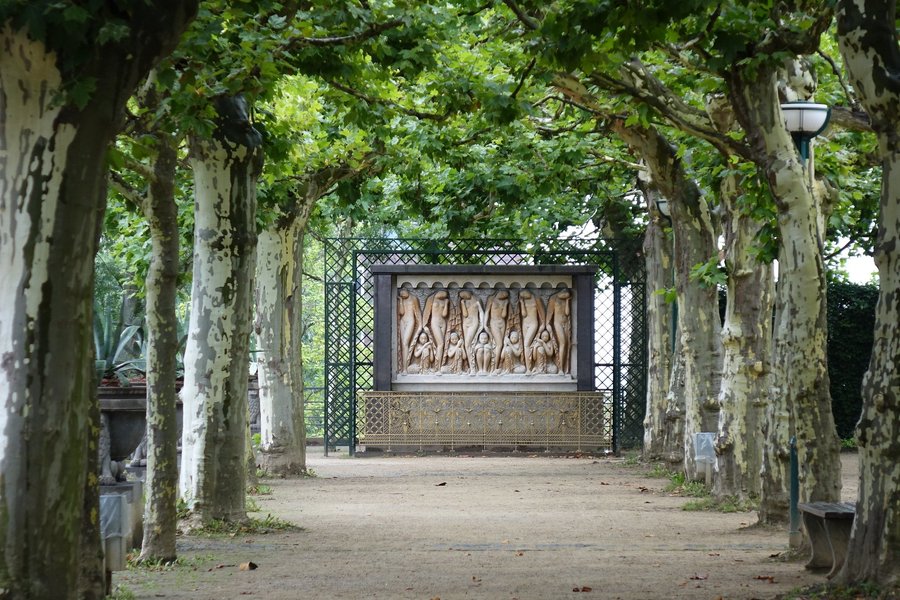
As an honorary Darmstädter (I live one town over with my wife), I was super excited when this was inscribed! It is a unique period in art history, one I was not that familiar with, but the buildings are visible from afar and have a unique feel to their look, thanks to their excellent preservation. It's small, compact, and easy to visit!
Keep reading 0 comments
This place is right up UNESCO's street, so if the inscription process takes place this year, I should imagine this will almost certainly be successfully inscribed.
It was also a lot more up my street than I expected. Although this is a relatively small area, we enjoyed strolling amongst the exhibition halls, gardens etc, even though it only lasted around 20 minutes!! Sadly the main exhibition hall attached to the wedding tower is currently undergoing major restoration work, so is covered in scaffolding. I liked the Swan Temple particularly.
My favourite part though was the artists houses. I understand that most are now in private hands, but it would be great if the opportunity arose, for at least one of them to be accessible to the public. Again Olbrich House is being restored so the exterior tilework is not really visible at this time. I liked all the houses but the standout one for me is the Behrens House.
Overall I didn't expect the colony to feel so 'complete', so obviously different from its surroundings, and so easy to interpret. The design ideals represented here are very well preserved in the architecture, and remain authentic despite the disruptions of recent history.
Keep reading 0 comments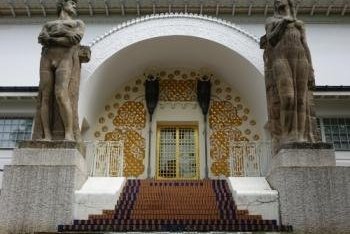
Germany is working towards a 2020 nomination for the Artists' Colony Mathildenhöhe in Darmstadt. This is a Gesamtkunstwerk of buildings, gardens and works of art, created during the years 1901-1914 over the course of four exhibitions. The art-loving Hessian Grand Duke Ernst Ludwig was the patron for the notable Jugendstil artists that were part of this community.
I had never been to Darmstadt before, and I visited it for a night and a morning on my return from the Ice Age Art Caves. My first impression was that of a rather dull city. It is large enough though to have its cosmopolitan edges – I ate at a Peruvian restaurant on Saturday and a Persian one on Sunday right after visiting Mathildenhöhe (the recommended Shiraz which is within walking distance). To find a site like the Artists’ Colony in a city like this still is a real surprise.
Mathildenhöhe is signposted all over Darmstadt. It’s a small quarter just northeast of the city center. The core consists of a block with the Wedding Tower and the Exhibition Building, with the emblematic Russian Orthodox Chapel and the Platanenhain (sycamore grove) in front of it. Around this cluster lie a number of houses created for and by the artists. It has the general atmosphere of a public park, and many locals were also out for a Sunday stroll. People also were entering the Russian Chapel to pray. The chapel has no direct link to the Artists' Colony but it greatly adds to …
Keep reading 0 comments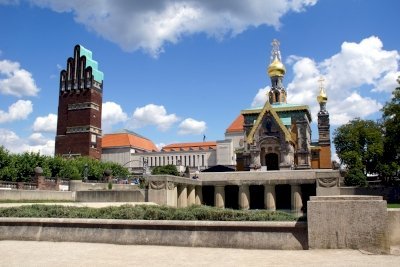
The Mathildenhöhe Artists' Colony is one of the most promising candidates on the new German tentative list, and it is also a site which I would like to see inscribed. The artists' colony was founded in 1899 by the Grand Duke of Hesse to stimulate industry and crafts with innovative ideas. Until the beginning of World War I, several artists of the Art Nouveau showed in four exhibitions their ideas of architecture, design and visual arts. In some ways, the Mathildenhöhe colony represents the transition between Art Nouveau and Modernism. The most influential artists in Darmstadt were the Austrian architect Joseph Maria Olbrich, who had planned most of the buildings, and Peter Behrens, best known for his later industrial buildings and design.
The Mathildenhöhe is a hill close to the city centre, the proposed area comprises the permanent buildings of the four exhibitions, particularly the two exhibition halls and the artists' houses. But it also includes small structures such as sculptures, a water basin, a pavillon. The most striking building is the Wedding Tower, the landmark of Darmstadt.
I used to live near Darmstadt and I have visited the artists' colony many times. I agree with Assif, that it is a nice place to spend a Sunday afternoon. The buildings are very well described in his review below, thus just a few additional comments:
The Orthodox Church was built shortly before the artists began their work, and although it was constructed in the style of Russian churches …
Keep reading 0 comments
We have already got a connection "Art colonies", however, Mathildenhöhe in Darmstadt will probably become the first site the OUV of which lies in its function as such, unless Cubanacan makes it on the list before. Mathildenhöhe is probably one of the first modern art colonies and among the most famous ones. It was built ex nihilo in the beginning of the 20th century and conceived as a innovative art colony. The artists were also encouraged to build their villas at the site.
Despite grave destruction during WWII the site survived and makes an authentic impression, although some of the original buildings no longer stand. The complex includes a fountain, a sculpture garden, the Orthodox church, the iconic Nuptial Tower, the two exhibition halls and the nearby artists villas. Living next to Frankfurt, Mathildenhöhe makes an easy day trip by public transport and I spent several Sundays enjoying it. Some comments on the visit:
The Orthodox church: It seems to have very beautiful interior, but it is still an active church. Each Sunday I came a mass was underway and I could not enter the building. It is not too big and it seems it attracts numerous prayers from the entire area, so even a short glimpse proved impossible through the crowds blocking the entry.
The Nuptial Tower: Do not buy the (cheap) tickets for visiting the tower. Three impressive rooms are featured in the tower. The first is the hallway covered with beautiful mosaics. It can be accessed without …
Keep reading 0 comments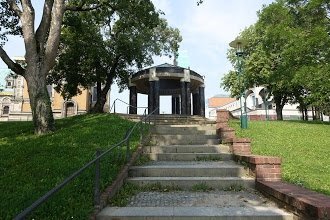
Following in my travel plans on Els footprints, I ventured to Darmstadt on the same weekend as my visit to the Ice Age Caves.
During my visit the Mathildenhöhe was fairly busy with plenty of tourist groups roaming the area. Several parts of the site were closed and undergoing renovations. In addition, the wedding tower was closed for … weddings. Still, I feel I managed to get a good look.
OUV
On the one hand side I get Els overall point. This is a consistent ensemble of Jugendstil buildings. The museum on site provides a great overview of the art objects created in the artist's colony. And while several of the buildings are off limits, you still get to see a lot of the Jugendstil interior design by visiting the museum and the wedding tower.
On the other hand side I left the site having taken less than ten pictures during my visit, all of them mediocre at best. Now, admittedly, I wasn't in the best possible shape. During the previous night there had been an oversupply of drinks and an undersupply of sleep. Still, I really tried to find a nice shot on a sunny day with blue skies and couldn't.
Part of it was due to the ongoing repair works of the site. In preparation for the world heritage site bid, the authorities have started renovating several of the buildings. Especially the artist houses seem in dire need of some construction …
Keep reading 0 comments
